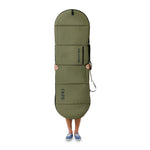Surfing is an adventure of its own. But as with every other sport, it comes with a set of dangers. Getting an injury or two during surfing is quite common, but understanding these potential hazards is the first step in preventing them. In this article, we'll explore some of the most common surfing injuries and offer practical prevention tips to keep you safe in the waves. Let’s get started.
Lacerations and Bruises
Lacerations and bruises make up almost 42% of all acute surfing injuries. The most common injuries in surfing are ones that are caused by your own gear. Whether it's a sharp fin slicing through the skin or a collision with the board, these injuries can happen in an instant.
Lacerations from contact with the surfboard or rocks underwater can result in cuts that may require stitches. Bruises, on the other hand, often occur from getting hit by your board or even wipeouts.
Properly clean and treat any wounds to prevent infection and promote healing. Wear protective gear like wetsuits and rash guards to help reduce the risk of lacerations and bruises while surfing.
Knee Injury
Knee injuries are a common concern for surfers, often caused by the dynamic movements required to ride waves. Surfing is a taxing sport. The repetitive bending and twisting motions can put a strain on the spine and knee joints over time.
Surfers may experience issues like sprains, strains, or even more serious conditions such as ligament tears. These injuries can be painful and impact your ability to surf for a long time.
Strengthening the muscles around the knee through targeted exercises both on land and in the water can help you prevent such injuries. This also helps provide your body support and stability on the board.
Wearing a supportive knee brace while surfing can also offer added protection against sudden twists or impacts that could aggravate existing knee problems.
Ankle Injuries
Surfing in challenging conditions or attempting advanced maneuvers without proper warm-up can increase the risk of ankle injuries. Surfers should pay attention to their foot placement and avoid putting excessive pressure on one ankle.
Wearing supportive footwear like water shoes or neoprene booties can provide extra protection for your ankles while surfing.
Ignoring minor discomfort or pain in your ankles can lead to more serious issues down the line, so it's essential to listen to your body and seek medical attention if needed. Remember, taking care of your ankles is crucial for enjoying long hours out on the waves!
Shoulder Impingement
Surfers spend half of their time paddling rather than surfing when in the water. These continuous paddling movements can cause shoulder impingement. Shoulder impingement causes the shoulder joint to become inflamed and painful, due to repetitive overhead motions. This can limit movement and impact performance in the water.
The pain from shoulder impingement can be sharp or dull, making it challenging to continue surfing without proper treatment. Ignoring this injury can lead to chronic issues that may require extensive rehabilitation.
To prevent shoulder impingement, surfers should focus on strengthening their rotator cuff muscles and maintaining proper paddling technique.
Hip Flexor Strain
A hip flexor strain occurs when the muscles that help you lift your knee toward your body become overstretched or torn.
These strains can happen when surfers make sudden movements or land awkwardly on their boards. The pain from this injury can range from mild discomfort to severe sharp pain in the front of the hip or groin area.
If you do experience a hip flexor strain, rest is crucial for recovery. Ice packs and anti-inflammatory medication can also help reduce swelling and pain.
To prevent hip flexor strains while surfing, you must warm up properly before hitting the waves and practice your landing techniques before jumping into the water.
Fracture
Hitting the water or colliding with your board in a way that is too forceful for your bones to handle can cause a fracture. The most commonly seen fractures in surfing are ones in the arms, legs, and ribs.
A fracture can be painful and debilitating, requiring time off from surfing to heal properly. Getting treated by a medical professional and taking time off to rest are key for recovery.
To avoid fractures, practice good form and technique when paddling into waves or maneuvering on your board.
Surfers Ear
Surfers Ear is a condition that many wave riders are familiar with. As the name implies, it's an ailment commonly caused by exposure to cold water and wind while surfing. This can lead to irritated bony growths within the ear canal, resulting in blockages and potential hearing issues.
The good news is that wearing earplugs can significantly reduce your risk of developing Surfers Ear. By keeping your ears protected from prolonged exposure to cold water and wind, you're taking proactive steps toward preventing this common surfing injury.
If you do start experiencing symptoms like ear pain or difficulty hearing, you must seek medical attention promptly. Early detection and treatment can help manage Surfers Ear before it progresses into more severe complications.
In What Ways Do Surf Injuries Differ From Other Sports Injuries?
The ocean presents unpredictable challenges, including strong currents and sharp reefs, increasing the risk of injury. Surf injuries differ from other sports injuries due to the unique environment surfers are exposed to. Unlike sports played on stable surfaces, surfing involves riding waves that can vary in size and power, leading to falls and collisions with the board.
Surfers also face prolonged exposure to water and sun, which can lead to conditions like surfer's ears or skin irritations. The repetitive paddling motion in surfing can cause strain on shoulders and hips over time. Surfers also need strong core muscles for balance and stability on the board, resulting in potential muscle imbalances compared to land-based athletes.
Preventative Measures
One common mistake many surfers make is neglecting proper warm-up exercises before hitting the waves. Regular stretching and strengthening exercises can help prevent muscle strains and tears. Focus on building core strength, flexibility, and balance to improve overall stability while surfing.
Another frequent error is overestimating your skill level and attempting advanced maneuvers too soon. Don't push yourself beyond what you're comfortable with or attempt maneuvers that are beyond your skill level.
Failing to listen to your body and pushing through pain or fatigue can lead to overuse injuries that may sideline you from surfing for an extended period.
Always be aware of other surfers around you and practice proper surfing etiquette to minimize the chances of collisions or accidents in the water. By staying alert, respecting others' space, and following safety guidelines, you can enjoy a safer and more enjoyable surfing experience without putting yourself at risk for potential injuries.
Regular inspection and waxing routines can help prevent your surfboard from deteriorating before time. A good waxing routine ensures that you won't lose traction and slip off the board mid-ride.
Be sure to keep your equipment safe too. A surfboard in good condition can help you surf more smoothly and efficiently.
Investing in quality surfboard protectors like surfboard bags and cases can help prevent damage to your gear and reduce the risk of injury. FARO’s surfboard bags are made by keeping the surfers comfort in mind. These Longboard bags and board cases are designed with durable, eco-friendly materials for long-term sustainability.
Health Benefits of Surfing
Surfing is an extreme sport. And like every other extreme sport, it brings some dangers with itself. Despite the risks, surfing offers numerous physical and mental health benefits:
-
Full-Body Workout: Surfing engages multiple muscle groups, including your arms, shoulders, core, and legs. Paddling, balancing on the board, and maneuvering through the waves require strength and endurance.
-
Cardiovascular Fitness: The continuous paddling and riding waves offer an excellent cardiovascular workout, improving heart health and increasing your stamina.
-
Improved Balance and Coordination: Maintaining balance on a moving surfboard in the water calls for constant adjustment and coordination. Over time, surfing can help improve your balance, and even sharpen your coordination.
-
Stress Relief: The rhythmic sounds of the ocean, the sensation of gliding on waves, and the calming and serene environment help you relieve stress and provide a mental escape.

Conclusion
Getting injured while surfing is part of the adventure. Understanding common risks and practicing safety guidelines can help you minimize the likelihood of sustaining an injury. Remember, safety should always be a priority when riding the waves. So, take preventive measures and be mindful of surfing etiquette so that you can keep on surfing for a long, long time!





